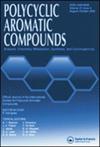Pyrazine-Based Aromatic Dyes as Novel Photosensitizers with Improved Conduction Band and Photovoltaic Features: DFT Insights for Efficient Dye-Sensitized Solar Cells
IF 2.6
3区 化学
Q2 CHEMISTRY, ORGANIC
引用次数: 0
Abstract
Dye-sensitized solar cells (DSSCs) have garnered significant attention due to their exceptional ability to convert solar energy into electricity at a relatively low cost. Novel organic photosensitizers (FZB1-FZB9) from the pyrazine-based aromatic dye (E)-3-(5-(2,3-bis(40-(diphenylamino)-[1,10-biphenyl]-4-yl)-7 (trifluoromethyl)quinoxalin-5-yl)thiophen-2-yl)-2-cyanoacrylic acid (TPPF) have been quantum chemically modeled for their application in dye-sensitized nanocrystalline TiO2 solar cells (DSSCs). The electrochemical and photovoltaic features of modeled dyes are investigated by performing DFT insights, i.e. FMOs, absorption maxima, DOS, TDM, NBO, exciton and binding energy, radiative lifetime analysis (ꚍ), electron-injection (Δ and regeneration analysis ()@TiO2. FMO analysis confirmed the better electron injection as HOMO of designed dyes was found to be more positive than redox potential I/I3 (-4.8 eV), and the LUMO appeared more negative than the conduction band of TiO2 (-4.0 eV). The modeled photosensitizers exhibited red shift λmax from 338-494 nm with a lower energy gap from 5.62 eV in FZB (R) to 5.17 eV in FZB9. Bridging modification reduces the exciton and binding energy for designed dye FZB9 and FZB7 compared to reference FZB. The designed dyes appeared with a lower radiative lifetime of up to 1.32 than the reference dye of 1.63, better light harvesting efficiency (LHE), and the highest NBO charge on bridges of designed photosensitizers for enhanced light emitting efficiency. The investigated dyes exhibited more negative values for electron injection, i.e. −0.003 and the highest values of dye regeneration up to 11.717, which unveils innovative and effective injection of electrons toward semiconductor TiO2. Among all dyes, FZB8 proved best with the novel bridging modification that enables quick charge transfer as exhibited the lowest gap (5.17 eV), lowest excitation energy, better LHE, highest charge on LUMO and more negative electron injection (Δ The outcomes of this computational study confirmed that this research established a new benchmark for achieving novel and efficient photosensitizers, thus recommending them for future DSSC applications.
吡嗪基芳香染料作为新型光敏剂,具有改进的导带和光伏特性:高效染料敏化太阳能电池的DFT见解
染料敏化太阳能电池(DSSCs)由于其以相对较低的成本将太阳能转化为电能的特殊能力而引起了极大的关注。由吡嗪基芳香染料(E)-3-(5-(2,3-双(40-(二苯基氨基)-[1,10-联苯]-4-基)-7(三氟甲基)喹啉-5-基)噻吩-2-基)-2-氰丙烯酸(TPPF)制备的新型有机光敏剂(FZB1-FZB9)用于染料敏化纳米晶TiO2太阳能电池(DSSCs)。通过执行DFT洞察,即FMOs,吸收最大值,DOS, TDM, NBO,激子和结合能,辐射寿命分析(ꚍ),电子注入(ΔGinject)和再生分析(ΔGdyeregen)@TiO2,研究了模拟染料的电化学和光伏特性。FMO分析证实,所设计染料的HOMO比氧化还原电位I/I3 (-4.8 eV)更正,LUMO比TiO2的导电带(-4.0 eV)更负,具有更好的电子注入。模型光敏剂的红移λmax范围为338 ~ 494 nm,能隙较低,从FZB (R)的5.62 eV到FZB9的5.17 eV。与参考染料FZB相比,桥接改性降低了设计染料FZB9和FZB7的激子和结合能。所设计的染料的辐射寿命为1.32,比参考染料的辐射寿命1.63低,具有更好的光收集效率(LHE),并且在所设计的光敏剂的桥上具有最高的NBO电荷,从而提高了发光效率。所研究的染料具有更高的负电子注入值,为- 0.003,染料再生的最高值(ΔGregedyeregen)高达11.717,这揭示了半导体TiO2的创新和有效的电子注入。在所有染料中,新型桥接改性的FZB8表现最好,具有最低的间隙(5.17 eV),最低的激发能,更好的LHE,最高的LUMO电荷和更多的负电子注入(ΔGinject)。本计算研究的结果证实,本研究为实现新型高效光敏剂建立了新的基准,从而为未来的DSSC应用推荐了它们。
本文章由计算机程序翻译,如有差异,请以英文原文为准。
求助全文
约1分钟内获得全文
求助全文
来源期刊

Polycyclic Aromatic Compounds
化学-有机化学
CiteScore
3.70
自引率
20.80%
发文量
412
审稿时长
3 months
期刊介绍:
The purpose of Polycyclic Aromatic Compounds is to provide an international and interdisciplinary forum for all aspects of research related to polycyclic aromatic compounds (PAC). Topics range from fundamental research in chemistry (including synthetic and theoretical chemistry) and physics (including astrophysics), as well as thermodynamics, spectroscopy, analytical methods, and biology to applied studies in environmental science, biochemistry, toxicology, and industry. Polycyclic Aromatic Compounds has an outstanding Editorial Board and offers a rapid and efficient peer review process, as well as a flexible open access policy.
 求助内容:
求助内容: 应助结果提醒方式:
应助结果提醒方式:


